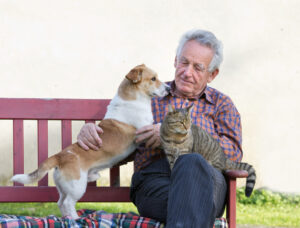Reading an animal’s body language is difficult. In fact, this ability is one of the most important skills a pet owner or veterinarian possesses. However, an animal’s body language is often misinterpreted and misunderstood.
When human beings meet a stranger, handshakes are often exchanged. Affection between humans is often expressed through physical contact. Dogs and cats cannot communicate in this manner. A dog expresses his thoughts and intent through body posture and non-verbal signals. Only through correctly interpreting their non-verbal signals can we identify what a dog is trying to tell us.

He bit out of nowhere
An animal does not bite “out of nowhere.” Aggression is used as a last resort. Animals will look away, avoid, or pull back their ears. If these subtle signs are ignored, escalation can occur. This may include stiffening, staring, snarling, or growling before actually biting. It is important to understand from an animal’s perspective, aggression is not without cost and may even result in injury or death. Aggression is only used if an animal determines it is necessary to end a conflict.
When an animal’s warning signs are ignored, escalation may occur. Punishing aggression is easy but is it effective? Punishment does not address the underlying emotion responsible for an animal’s aggression. However, punishment will cause the animal to suppress warning signals. Escalation such as biting occurs when an animal learns non-verbal warning signals do not stop an uncomfortable situation. Chances are quite good a dog that bites “out of nowhere” at one time tried communicating their displeasure through the use of non-verbal warning signs which were ignored.
Wagging tail means happy dog
When a dog approaches a person, they are often curious and investigating the person. It is easy to misinterpret this situation. The body posture of a friendly dog is quite different from that of a fearful dog. If their tail is down, ears back and weight shifted backward, they are often communicating fear. A fearful dog may wag their tail. A wagging tail does not mean a dog is happy. It signals arousal which means the intensity of emotion. An approaching dog with a wagging tail can bite an outstretched hand because, in all likelihood, he is fearfully aroused.

Who wants a belly rub?
Does a cat or dog who rolls onto their back exposing their belly want a belly rub? It is possible however, this behavior can be communicating something else entirely. Cats often lie on their back in a defensive nature. This is not an invitation for a belly rub. If a dog is comfortable with the person petting them, she may roll over on her back for a belly rub. However, if she rolls over on her back as soon as she is approached, this is submissive behavior. Perhaps she is communicating fear or anxiety. The best approach in this case would be to call the dog over without leaning or reaching over them so they do not feel intimidated. Rolling a dog onto his back to give him a belly rub may cause anxiety and make him upset.

Our pets provide such joy and love. They do so without being able to communicate verbally. Taking some time to consider their body language and non-verbal signals is the least we can offer to demonstrate our love and commitment to their well being and safety.
